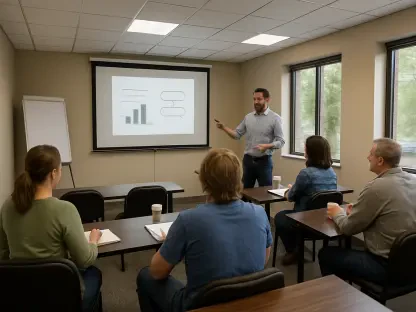The significant and concerning trend of declining preschool enrollment rates in some of New Jersey’s poorest school districts, specifically focusing on 3- and 4-year-olds eligible for full-day preschool programs, has drawn the attention of educational authorities and policymakers. A comprehensive study by the Education Law Center reveals a startling figure: nearly 10,000 young children in these districts are not enrolled in preschool, despite being entitled to it. This situation raises critical questions about the effectiveness and accessibility of early childhood education in underprivileged areas.
Declining Enrollment Targets
Failing to Meet Enrollment Goals
Initially, the report underscores that the majority of these districts are not hitting their enrollment targets. Only five out of New Jersey’s 31 low-income districts reached the 90% enrollment threshold for the 2023-24 school year. The districts meeting this benchmark are Hoboken, Harrison, Irvington, Millville, and Salem. This marks a stark contrast to the 2009-10 school year, in which 18 districts achieved this target. The steep decline in enrollment is attributed to a variety of factors, with the COVID-19 pandemic playing a significant role in exacerbating existing enrollment losses. This trend represents a troubling scenario for early childhood education in impoverished areas.
Reports indicate that many parents may still feel the effects of the pandemic and its impact on everyday life, which might include apprehensions about sending their young children to school settings where they perceive potential safety risks. Additionally, disruptions caused by the pandemic have likely influenced long-term planning and community engagement efforts, further affecting parents’ decision to enroll their children in preschool. These setbacks point to a complex interplay of factors affecting the ability of districts to meet desired enrollment targets.
Long-Term Decline
Moreover, the report states that only four of these districts observed an increase in preschool enrollment since 2009, signaling a long-term decline that predates the pandemic. The pandemic, however, significantly accelerated this downward trend, with nationwide preschool enrollment dropping almost 10% between 2019 and 2021. Despite efforts to recover post-pandemic, the current enrollment figures still lag behind pre-pandemic levels. In the 2023-24 school year, just around 35,000 out of an estimated 45,000 eligible children were enrolled in preschool, amounting to merely 78% of the eligible population.
Various socio-economic challenges compound this complex issue. Many families in low-income districts face barriers such as lack of access to transportation, limited awareness of the benefits of early childhood education, and logistical difficulties arising from working schedules. These factors, combined with economic hardships exacerbated by the pandemic, contribute to the persistent and troubling trend of low preschool enrollment in New Jersey’s poorest districts. Addressing these issues requires a multifaceted approach that takes into account these socio-economic realities, planning long-term measures, and ensuring consistent support for families.
Lack of Mandatory Enrollment
No Penalties for Low Enrollment
Despite the alarming statistics, enrolling children in preschool is not mandatory, and districts face no penalties for failing to meet targets. This lack of compulsion may contribute significantly to the declining numbers, as there may be insufficient motivation or resources dedicated to boosting enrollment rates. Danielle Farrie, the center’s research director and co-author of the report, emphasizes the critical importance of early childhood education, citing robust evidence of the academic and social benefits offered by high-quality pre-K programs. Particularly in New Jersey, these programs have shown to be highly beneficial.
However, without a mandatory requirement, the onus falls on individual districts to promote enrollment actively. This situation can lead to disparities in efforts and resources, with some districts more capable of launching effective outreach campaigns than others. The absence of state-mandated incentives or penalties means that boosting preschool enrollment relies heavily on district-level initiatives, which can be inconsistent and vary in effectiveness. To address this, a more unified and compelling approach may be needed to ensure that all eligible children have access to early childhood education, regardless of their district’s resource capacities.
Need for Proactive Measures
The report calls for more proactive measures to counteract this decline. Potential reasons for low enrollment include inadequate outreach efforts and residual impacts of the pandemic that deter families from participating in preschool programs. Farrie suggests a revitalized and robust state-level campaign to inform and encourage parents about the benefits and availability of preschool programs. Historically, significant pushes to advertise these programs have demonstrated success, and the current dwindling enrollment figures indicate the need for a similar concerted effort.
Renewed state-level initiatives could include multimedia advertising campaigns, community events, and collaborations with local organizations to reach parents more effectively. Additionally, facilitating easier access to enrollment information and providing support services for families could alleviate some of the barriers to participation. Addressing misconceptions and educating families about the critical role of early childhood education also form an essential part of these efforts. A comprehensive strategy will require state and local authorities to assess current outreach methods and explore innovative solutions to re-engage families in these vital educational opportunities.
Addressing Infrastructure and Funding
Infrastructure Deficiencies
In terms of infrastructure, the New Jersey Schools Development Authority has identified significant deficiencies in preschool capacities within 10 districts. Addressing these deficiencies is crucial as it would allow districts to expand and accommodate more students. Nicole Ciullo, the associate director of policy at the Education Law Center and co-author of the report, stresses the importance of having adequate classroom space to meet rising enrollment demands. Increasing enrollment is indeed beneficial, but it necessitates corresponding increases in physical capacity to house students, ensuring that high-quality education can be provided without overcrowding.
Equally important is the need to modernize existing facilities to meet the current standards for early childhood education. Many preschool programs operate in outdated buildings that lack essential resources and amenities conducive to effective learning environments. Investing in the renovation and expansion of these facilities can play a significant role in boosting enrollment rates, as parents are more likely to enroll their children in programs where they perceive the physical environment to be safe, well-equipped, and conducive to learning. This also involves ensuring that schools possess the necessary materials, resources, and trained staff to meet the growing needs of their preschool populations.
Revisiting School Funding Formula
The report advocates revisiting the state’s school funding formula to ensure per-pupil spending is adequate to meet these districts’ needs. The recurring theme underscores a call for state intervention to facilitate the growth of preschool enrollment. Additional funding and improved outreach are seen as pivotal in ensuring that eligible children receive the benefits of early childhood education, which are known to have long-lasting positive impacts on their educational trajectories.
The funding formula needs to be analyzed carefully to address disparities and ensure that resources are distributed equitably among districts, particularly those showing significant under-enrollment. This includes providing targeted financial support for initiatives aimed at increasing enrollment, enhancing infrastructure, and comprehensive community engagement efforts. Revised funding also should consider the full spectrum of operational costs – from hiring qualified teachers to maintaining safe, accessible facilities. Ultimately, equitable and adequate funding will be critical to empowering all districts to foster an environment where every eligible child can access and benefit from high-quality preschool education.
Recommendations for State Action
Understanding Underlying Causes
The Education Law Center recommends that the New Jersey Department of Education intensify efforts to understand the underlying causes of declining enrollment and to devise strategies to reverse these trends. This incorporates fostering better collaboration between school districts and preschool programs, with particular focus on enrolling three-year-olds. The center emphasizes the necessity of increased funding and improved infrastructure to accommodate growing preschool populations, recognizing that such improvements are integral to boosting overall enrollment and ensuring children receive early educational advantages.
Moreover, the emphasis on collaboration extends to engaging families and communities in meaningful ways. Building partnerships with local organizations, healthcare providers, and community leaders can help gain insights into the barriers families face and devise more effective solutions. Understanding cultural, logistical, or economic factors that may be influencing enrollment decisions will allow for tailored approaches to outreach and support. Encouraging family involvement in preschool programs, providing translation services, and addressing specific community needs are strategies that can be integrated into a holistic plan to improve enrollment rates.
Renewed Outreach Campaigns
New Jersey’s poorest school districts are experiencing a troubling decline in preschool enrollment rates, especially among 3- and 4-year-olds who qualify for full-day preschool programs. This significant issue has caught the attention of educational authorities and policymakers who are concerned about the accessibility and effectiveness of early childhood education in these underprivileged areas. According to a comprehensive study conducted by the Education Law Center, nearly 10,000 young children in these districts are not enrolled in preschool, even though they are entitled to it. This alarming statistic raises critical questions about why so many eligible children are missing out on early education opportunities and what can be done to improve enrollment rates. The study suggests potential barriers such as lack of awareness among parents, insufficient outreach by schools, logistical challenges, and possibly even funding limitations. Addressing these challenges is crucial for ensuring all children have a strong educational foundation and better future prospects.








